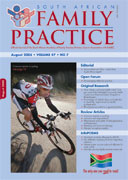CPD: Urticaria and Angioedema: A Practical Approach.
Abstract
Urticaria (i.e., pruritic, raised wheals) and angioedema (i.e., deep mucocutaneous swelling) occur in up to 25 percent of the U.S. population. Vasoactive mediators released from mast cells and basophils produce the classic wheal and flare reaction. Diagnosis can be challenging, especially if symptoms are chronic or minimally responsive to therapy. A thorough medical history, physical examination, and methodical investigation are necessary to uncover diagnostic clues. Although serious medical illness can occur concurrently with chronic urticaria, acute urticaria generally is benign and self-limited. The mainstay of therapy for urticaria is avoidance of known triggering agents, judicious use of oral corticosteroids, and treatment with long-acting second-generation antihistamines, H2-receptor antagonists, tricyclic antidepressants, and antiinflammatory leukotriene antagonists. Consultation for investigative therapy may be necessary if symptoms continue despite a stepwise approach to diagnosis and therapy. (SA Fam Pract 2005;47(7): 20-23) (Reprinted with permission from American Family Physician 2004;69(5):1123-1128. Copyright © American Academy of Family Physicians. All rights reserved.) Permission from the AAFP was granted to publish this article in the hardcopy only. Kindly refer to www.aafp.org or subscribe to the hardcopy of South African Family Practice.
Published
2005-08-01
Section
Review Articles
By submitting manuscripts to SAFP, authors of original articles are assigning copyright to the South African Academy of Family Physicians. Copyright of review articles are assigned to the Publisher, Medpharm Publications (Pty) Ltd, unless otherwise specified. Authors may use their own work after publication without written permission, provided they acknowledge the original source. Individuals and academic institutions may freely copy and distribute articles published in SAFP for educational and research purposes without obtaining permission.

